#Dermatologically Tested
Explore tagged Tumblr posts
Text
Top Dermatology Care in Hyderabad | Specialists | Omega Hospitals
Discover expert dermatology care at Omega Hospitals, Hyderabad. Our specialists offer advanced treatments for skin diseases, ensuring lasting solutions.
0 notes
Text
dear, Klairs All-day Airy Sunscreen – review (for All Skin Types)
Incredibly light to be a moisturising sun cream but it's real: dear, Klairs is back with its All-day Airy #Sunscreen. #Koreanskincare
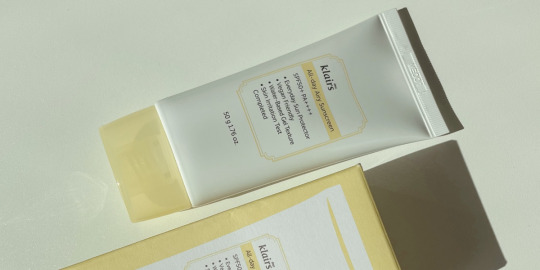
View On WordPress
#chemical sunscreens#cruelty free#dear Klairs#dermatologically tested#finish: dewy#for all skin types#Korean skincare#moisturising#not tested on animals#review#SPF#Sponsored: unpaid#tested by me#texture: fluid cream#vegan
0 notes
Text
#mild cleanser#mild cleanser for sensitive skin#dermatouch#skincare products#best mild cleanser#Cleansing Lotion#dermatologically tested#Mild Cleansing Lotion for Sensitive Skin
0 notes
Text
#Bare Anatomy Anti Hair Fall Shampoo#5x Hair Fall Control & Growth#Contains Biotin Adenosine#& Peptides#Paraben & SLS Free#Dermatologically Tested#Vegan
0 notes
Text
I don’t walk, I aggressively swing on my little sisters children’s swing set.
No I actually mean it.
THE POINT IS IM MICRODOSING ADRENALINE OK??
If you’re experiencing writers block, make a playlist with songs that remind you of your WIP and go on a 30 min walk.
Trust me.
#microdose adrenaline for better writing results#10/10 fat pigeons recommend#side effects may include:#forgetting to eat#forgetting to dink#forgetting to shower#forgetting to pee#forgetting to write anything down#forgetting where you are#forgetting who you are#forgetting that you exist and fading out of existence#dermatologically tested#for sensitive skin#writeblr#writing blog#original writing#writers of tumblr#creative writing#writers on tumblr#writing#writerscommunity#writer problems#writing a book#I am not on drugs
3K notes
·
View notes
Text

Eosinophils on a skin cytology from a cat suffering from eosinophilic granuloma complex.
#veterinary#vet tech#diagnostic testing#white blood cells#skin cytology#eosinophils#eosinophilic granuloma complex#cat#allergies#dermatology
10 notes
·
View notes
Text
Discover the power of SunShield Mineral SPF 50++++ by Barclay Italy, the ultimate sunscreen designed for Indian skin. Get broad-spectrum protection, no white cast, and a skin-friendly formula for all-day defense against UV rays.
#anti-aging sunscreen#Barclay Italy#best sunscreen for sensitive skin#blue light protection#broad-spectrum protection#daily sunscreen#dermatologically tested sunscreen#lightweight sunscreen#mineral sunscreen#non-greasy sunscreen#skincare#SPF 50++++#sun protection#sunscreen#SunShield Mineral SPF#UVA UVB protection#water-resistant sunscreen
0 notes
Text
yea, those are not well researched. we do know what causes frequent yeast infections, it's just that multiple causes are at play. and what makes a treatment decent, according to you?
is fat removal surgery decent? are breast implants decent? are quack creams that do nothing that vaseline couldn't do decent?
wild how like PCOS, endometriosis, vaginismus & hell, even frequent yeast infections are “mysterious” with no well known cause and little to no decent treatment, but we have tons of supposedly well researched body fat removal methods, about 20 different kinds of breast implants, laser hair removal, and 100 different dermatologist recommended anti aging creams. we sure had the money and brainpower to cure those “diseases”
#it's not about money and brainpower to make women pretty#it's easier to make bullshit creams#give them to 20 women#and say its been dermatologically tested#and the cosmetic interventions are just way less regulated as to what they're allowed to claim about their product#i just really don't get this post because it takes the wrong conclusions based on righteous anger#there is no research money going into fat removal that would otherwise have gone into endometriosis research.
113K notes
·
View notes
Text
you're laughing. your dad just told you, age 26, that your family has chronic liver issues, and you're laughing.
#moss.french#least involved guy on the planet wins I guess???#Mr Guy my liver has shown signs of damage for years and you haven't thought of sharing this before???????#to be fair what the fuck was up with my old GI who read those blood tests and said yeah that's fine#Anyway. ahah. eheh.#MRI soon.... Biopsy later......... Call Mr AllDepartmentsWide#Dermatology. GI. Hepatology. Boomers in the waiting room wish they were me.#I'm kidding BTW eheh I'm trying not to get too mad sad despaired etc#remember when instead of connecting the fact that overuse of steroids caused bone erosion#I was just given opioids to deal with the “mysterious” pain#Remember when medication caused my psoriasis but we kept me on it#And said psoriasis spread so much that I could have died lol#Remember when my liver results have been showing damage for years and I might Just Have chronic liver disease but#It took me moving here for it to make sense#Ohhhhhh myyyyyy godddddd#perhaps I should become moss frfr#Anyway. In non complaining news I made good progress on translation today
1 note
·
View note
Text
I have worked in industry for TEN FUCKING YEARS and only just now figured out my skin issues are triggered by the hairnets we wear. I've seen dermatologists for this shit and they have all told me it's stress-related.
But some rando doctor covering for my usual GP saw the patches on my neck was was like "Hey, do you wear a hairnet regularly? It's super common for the dye in hairnets to trigger dermatitis."
And SURE-E-FUCKING-NOUGH I started wearing a headband so it doesn't press on my skin during the day and the patches are GONE. It doesn't itch! I don't have to apply steroid cream all the damned time anymore!
So public service announcement: if you have what you think is eczema on your scalp and neck and you work in an industry that requires hairnets, you too might have hairnet-induced dermatitis. Try a headband and/or bandana.
#apparently this has been a known thing since the 50s#and I already knew I was allergic to some nitrile dyes#but apparently it's easier to blame stress than do a fucking patch test#health issues#dermatology#work was literally making me unwell
0 notes
Text
Do you relate to the quote above? Are you tired of people asking if you are tired or stressed, no matter how well-dressed or made-up you are? Maybe it’s time to invest in your look with cosmetic injectables that don’t break the bank and don’t feel risky. Your face is something you show to everyone, after all. So you need to be confident with it. Bethany Medical Clinic is here to bring out the best version of yourself!
#dermatology clinic chelsea#primary care clinic chelsea#allergy treatment and testing nyc#hair loss treatment nyc#nutrition and diet clinic columbus circle#ultherapy clinic nyc#virtual medical consult nyc#women’s wellness clinic nyc#health memberships nyc
0 notes
Text
#health#skincare#product tested#product proven#healthcare#medical grade#post surgery care#aftercare#tattoos#eczema#dermatology#miracle in my eyes
1 note
·
View note
Text
Patch Testing Dermatology
Patch testing dermatology is a great way to find out what’s causing your rash. It’s safe and effective for adults and children alike. It’s also a great option for determining if you have an allergic reaction to a product or substance.
During the test, different substances are placed on the skin and taped in place. The dermatologist then reads the results after two days.
It’s a quick and easy test
Allergy patch testing dermatology is a simple and effective test that identifies chemicals that can cause a skin rash called allergic contact dermatitis. It helps patients reduce symptoms and prevent recurrence of itchy, painful and red, itchy patches on the skin by eliminating allergens from their routine.
During the test, dermatologists place small aluminum discs (Finn chambers) with various allergens on tape on your back. The allergens are mixed into a “standard series” to provide a good chance of eliciting an allergic response.
The tests irritate the skin, but itching is minimal and typically clears within days of the appointment. Those with darker skin tones may experience discoloration, but this typically fades over the course of a week.
After two days, the dermatologist removes the allergy patch testing disks and interprets the results. For best results, patients should avoid any soaps, lotions or ointments on the test area before and during the procedure. They should also avoid wearing any clothing that could rub against the test site.
It’s safe
Unlike prick or scratch test methods, patch testing does not use needles to detect an allergic reaction. Instead, chemicals that mimic allergens are placed on patches and then applied to your skin. The patches are removed at your second appointment and then read by a dermatologist or doctor. The results will determine if you’re allergic to one or more of the chemicals that are causing your rash. The bigger the wheal on the patch, the more likely you are to be allergic to that substance.
The patches may irritate the skin, but this is normal and should clear within a few days. It’s also important to bring any health and safety data sheets or product packaging that can help us identify the allergens causing your rash.
Your dermatologist will create a plan to help you avoid the substances that are triggering your allergies. This will improve your symptoms and prevent your rash from returning. For this reason, it’s best to visit a board-certified dermatologist for this type of allergy testing.
It’s effective
Patch testing is a standard technique to help diagnose the cause of an itchy rash called allergic contact dermatitis. It can also be helpful in uncovering the cause of other types of skin irritations, such as burning and itching.
During the test, dermatologists apply patches that contain various allergens to the patient’s back. These include chemicals like latex, medications, fragrances, preservatives and metals. Each patch is held in place with hypoallergenic tape. The patches must remain on for 48 hours, and patients are encouraged to avoid showering or activities that may induce excessive sweating.
Patients should tell their doctors about any medications they are taking because some may interfere with the results of the test. This includes immunosuppressive drugs such as azathioprine, cyclosporine, tacrolimus and mycophenolate mofetil. These drugs inhibit the migration of Langerhans cells and prevent the activation, proliferation and maturation of T lymphocytes. This can lead to a false negative result in patch tests.
It’s affordable
If you are suffering from itchy, painful, scaly skin that appears without warning and does not go away even after using prescription creams and avoiding the offending substances, it could be a sign of allergic contact dermatitis. This is a common condition that can be caused by a wide range of things, including soaps, cosmetics, perfumes, jewelry, cleaning products, and plants.
Patch testing is a way to identify the substance that causes this allergic reaction, allowing you to avoid it and enjoy clearer, healthier skin. It also helps to prevent future flare-ups.
There are several ways to perform patch tests, but the most reliable and accurate method involves having your skin tested by a dermatologist. This usually requires 3 appointments over a week (Monday, Wednesday and Friday). It is important to bring health and safety data sheets or product packaging (which lists the individual allergen ingredients) with you to your appointment. Also, avoid applying any creams or ointments on the area of skin that will be tested.
0 notes
Text
Buy DERMATOUCH Undamage Matte Touch Sunscreen SPF 50 PA+++
Are you looking for best sunscreen spf 50? If you are searching for a sunscreen with broad-spectrum SPF 50, this Undamage Matte Touch Sunscreen SPF 50 PA+++ from DERMATOUCH is the right choice! Find the Right Sunscreen for You.
Dermatouch Matte touch sunscreen is formulated with a broad spectrum SPF 50 PA+++ to protect from sun damage, pollution and tanning. Dermatouch Matte Touch Sunscreen for men and women is fragrance-free, water/sweat resistant, broad spectrum, UVA-UVB protecting.
#best sunscreen#best sunscreen for dry skin#best sunscreen for oily skin#best sunscreen for women#best sunscreen for face#dermatologically tested sunscreen#best sunscreen for men#skincare products#skincareproducts#skincare
0 notes
Text

Hello and welcome back to my blog!
My fifth and final gift for the Petalruesimblr Advent Calendar is: Dermatology Career! This is my third full-time career that I've created for The Sims 3 and I'm so happy it is finally complete.
I just want to wish you all a very Merry Christmas and hope your holiday season is filled with joy and love! 💜
If you are interested, click on ’Keep Reading’ below for more information and pictures of the Dermatology Career.


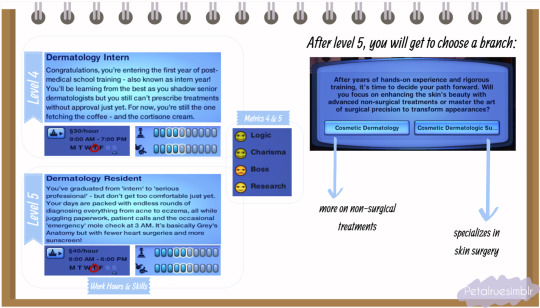

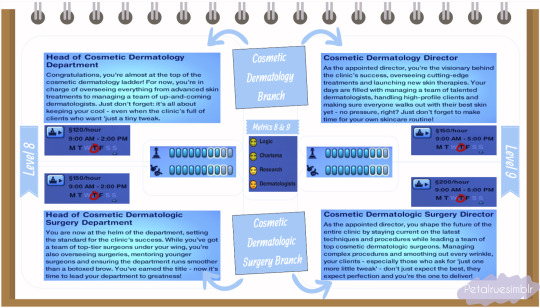
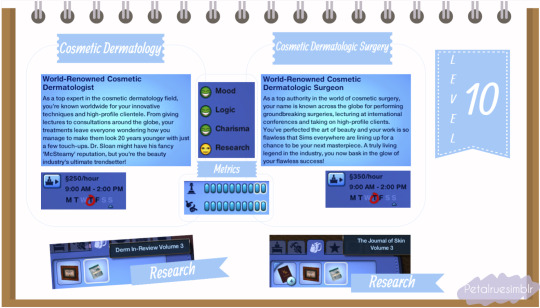
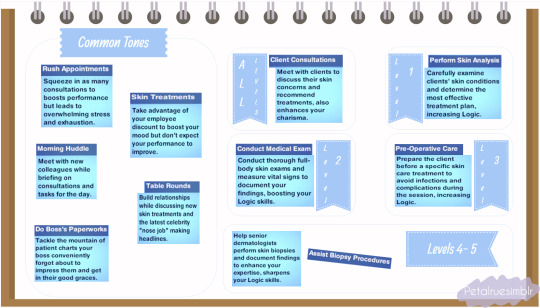
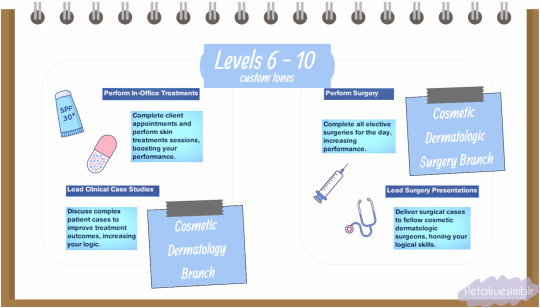




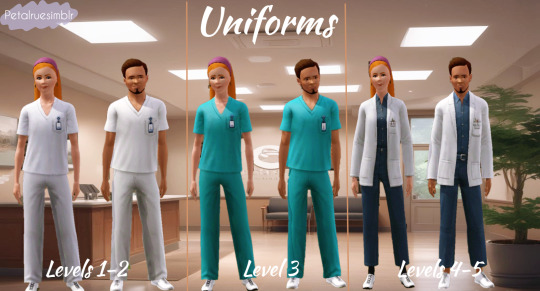

Dermatology Career

Sim File Share

Ready to get under the skin of the most fascinating (and sometimes most frustrating) aspects of beauty? The world of dermatology is calling! Whether you’re performing cutting-edge laser treatments or giving pep talks to patients with the occasional outbreak, there’s never a dull moment in the world of skincare. And who knows? Maybe you’ll even land an internship under Dr. McSteamy himself - so apply now!

Career Type: Full Time Available for: Young Adults, Adults and Elders Available Languages: English Levels: 10 Rabbit Hole: DaySpa Does it have Carpool? Yes Does it have Uniforms? Yes (details under Final Notes) File Type: Package Min. Required Game Version: 1.42 Packs Needed: The Sims 3 📣All descriptions for the levels, tones and metrics as well as skills required, salary, uniforms and other details are provided on the pictures above. Right-click on a picture and select ’Open image in new tab’ for a clearer view.

NRAAS Careers Mod

Branches and Wages: I decided to focus on two branches for my Dermatology career, which branch out after level 5: Cosmetic Dermatology, focusing on non-surgical treatments and Cosmetic Dermatologic Surgery, which specializes in skin surgery. The two branches share the same skill and metric requirements, as they are both part of the medical field. The main difference lies in their salaries, with the Cosmetic Dermatologic Surgery branch offering a higher pay. I aimed to make the wages as realistic as possible however to compensate for the increased days off and decreased work hours as the level increases, I had to raise the hourly wages beyond the normal salary ranges for Levels 6-10 for both branches. Metrics and Books: This career is similar to the medical career in The Sims 3, particularly in terms of the logic skill and research as part of its metrics. However, I also included charisma, as I believe it’s a vital skill for patients to trust and feel comfortable with their doctors, especially when it comes to skin treatments. Opportunities and Uniforms: With a bit of experience in creating opportunities, I decided to add four this time, three of which are repeatable! All of them are relatively simple and offer bonuses, as well as salary increases for some as rewards upon completion. For uniforms, I’ve provided a picture above to highlight the differences between the levels by assigning different colors to the scrubs. There isn’t a general color assigned to dermatology uniforms, as hospitals usually decide the scrub colors for their various departments. As stated above, you will need NRAAS Careers Mod for these careers to show up in the game and as long as you have the latest version of it, it should work for higher patches. You can also read my #psa regarding these careers, click here. I’m not fluent in any other languages to translate so if anyone is interested in translating this career, please don’t hesitate to send me a message here, comment on this post or let me know in my Ask/Contact form (if you don’t have a Tumblr account) and will let you know the details. I have tested this career in my game, so far it is working and all scripts are showing up. All feedback is very welcome to help me learn and improve my skills so please let me know if you experience any problems on your end and I’ll do my best to sort it as soon as possible.

MissyHissy step-by-step tutorial Twallan for the Career Mod S3pe
#petalruesimblr#custom career#the sims 3#ts3#ts3cc#sims 3#the sims 3 advent calendar 2024#ts3 simblr#ts3 advent calendar#ts3 simmer#sims 3 download#sims 3 screenshots#ts3 download#ts3 mods#ts3 community#ts3 screenshots#ts3 career#the sims 3 mods#the sims 3 career#the sims 3 advent calendar#advent calendar
243 notes
·
View notes